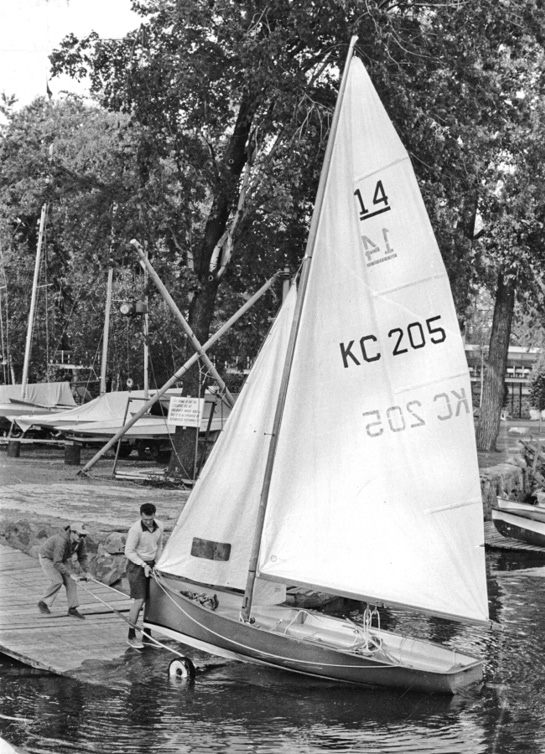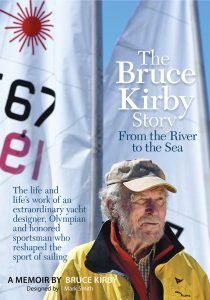
Torch hits the water with her bright orange topsides and promptly demonstrated her all-around speed. Mystic Seaport Museum Kirby Collection
Editor’s note: Our friend Bruce Kirby, a man who arguably did more to advance the growth and popularity of sailing than anyone else, crossed the bar on July 19, 2021 at age 92. A longtime resident of Rowayton, CT, Bruce had been working on his memoir with his friend Mark Smith of nearby Norwalk for two and a half years before his passing.
“Our collaboration was challenging and spirited,” says Mark. “It’s been a long road and a rewarding experience. Fifty-four years ago, Editor Bruce hired me for my first job as Art Director and Production Manager at One-Design Yachtsman,” Mark recalls. “I was there when the Laser was born and purchased Laser #7.”
Cowes 1958…
The race that propelled a young journalist into the precarious world of yacht design.
The International 14 team racing at Cowes in 1958 was a rough and tumble affair which came down to a race-off between New Zealand and Canada on a day when the wind rose from 18 knots at the start to a solid 32 knots at the dramatic finish. These wind velocities were reported by the Race Committee boat. This race-off against New Zealand also changed the course of my life, as it spurred me to put pencil to paper and design my first boat.
Ray Simich, New Zealand team manager and crew aboard one of the Kiwi boats, summed up that final race this way: “I’m going to put a spinnaker pole under my arm and start walking inland. When someone stops me and says ‘what’s that thing’ I’ll know I’ve gone far enough.”
A detailed recounting of each race in the series is not necessary, for in the end only one race counted, and that contest had enough action, anxiety, frustration and elation packed into it to last a lifetime.
The regular series ended with New Zealand and Canada tied with four wins and two losses each. Britain had fared badly, winning only one race, against Canada. It was decided that the tie would be broken by a single race. The course was buoys to port twice around a triangle of approximately three miles set in Osborne Bay, about two miles east of Cowes.
At the start the wind was blowing a manageable 18 to 20 knots but was increasing steadily. At the end of the rugged windward leg the New Zealand boat Calypso held first place by 75 yards, with Harry Jemmett and me in my Moonbeam, second, Ite of Canada third, Atua Hau, N.Z. fourth, Wee Wit, Canada, fifth and Boonerges, N.Z. sixth.
On the second leg, a reach with the 25-knot wind just aft of the beam we steadily overhauled the leader on a scorching plane and slid into first place. Coming into the jibe mark it was obvious the wind had shifted a bit to the left, making the next leg a dead run, so to avoid this awkward point of sail in such heavy air we laid off as far as we dared and continued on the starboard tack for about 300 yards before jibing.
Seemingly oblivious to the danger of running a high performance Fourteen dead before a 25-knot wind the rugged New Zealanders jibed close to the mark and set out straight for the committee boat.
Even with her slightly better wind angle, Moonbeam could not hold Calypso, which was planing off before the westerly blast as though it were a 10-knot breeze. Aboard Moonbeam the spinnaker was under discussion when teammate Paul McLaughlin, in third place, jibed and immediately lost his mast.
This gave the race an entirely new complexion because with one Canadian boat out the only hope was that the New Zealanders would also have their stroke of misfortune. At all costs Moonbeam had to be kept upright and in commission or even this glimmer of hope would be out of reach. The spinnaker stayed in the boat. At this point Calypso hoisted her spinnaker and broadened her lead. Astern of Moonbeam, New Zealand’s Atua Hau stuck to her working sails.
Starting at the second weather leg the wind was hitting 30 knots as reported later by the committee boat. The New Zealanders reveled in the conditions which were much like those found in Auckland and so little like those found on Lake St. Louis or Toronto Bay. Calypso steadily broadened her lead and Atua Hau passed the floundering Moonbeam so that at the weather mark the standing was New Zealand first and second, Canada third and fourth, New Zealand fifth. Wee Wit had suffered a partial broach at the jibe mark and had half filled with water. To keep her in the race, teammate George Whitaker had reached back and forth across the course for at least five minutes to give the suction bailers a chance to do their job. Meanwhile in last place New Zealand’s Boonerges had first broken her boom vang and sailed under jib alone while this was being repaired, and later in the race broke her jib halyard and continued under main alone.
The game appeared to be up for the Canadians as approaching the final mark and the dead run to the finish, Calypso held a healthy lead with Atua Hau second and Moonbeam, having gained only slightly on the beam reach, about 50 yards astern. Calypso made a good, controlled jibe and headed straight downwind under perfect control.
However, Atua Hau, on reaching the mark, headed up into the wind and dropped her mainsail. Aboard Moonbeam it appeared that the incomparable Geoff Smale was playing it safe and smart, but it turned out that Atua Hau’s mast had split and would have come all the way down if the main had not been dropped. As we planed into second place our responsibility became obvious. We had to press the leader as hard as possible hoping to force her to break down or capsize. But suddenly the New Zealand bubble burst. ■

The Bruce Kirby Story: From the River to the Sea is self-published by Kirby Smith Publishing, LLC (The Kirby Family Trust and Mark Smith), and is available at Amazon.com.
